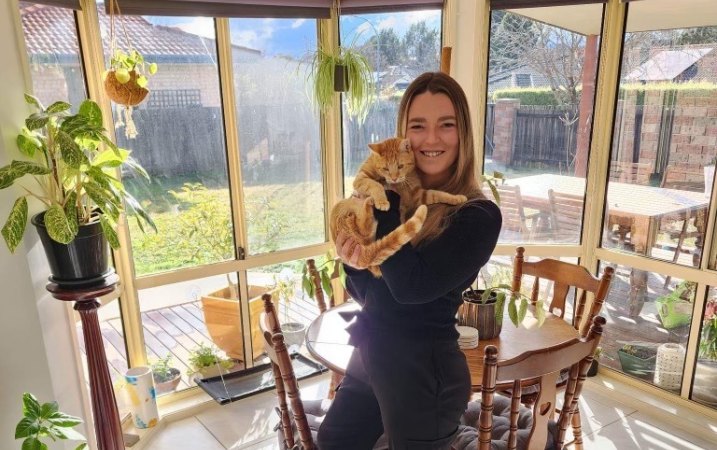Save articles for later
Add articles to your saved list and come back to them any time.
After renting more than 20 places, Grace Freeman said her last experience was great thanks to her landlord’s acceptance of pets and speed at repairing minor or major problems with the place.
“I was able to live my life as anybody who’s lucky enough to own a house or live with their parents is,” she said. “I knew that my landlord would treat me as a whole human being, pets included, and that we would just be able to work to resolve any issues that may arise – which never did.”
Freeman, who has a large German shepherd cross and two cats, rents in Canberra. The ACT’s renting regulations have come under the spotlight as the fight over housing policy between the federal government and the Greens continues, after the crossbench party this week delayed debate on Labor’s key housing legislation until the middle of October.
Grace Freeman said her last renting experience was great, thanks to her landlord’s acceptance of pets and speed at repairing minor or major problems with the place.
A standoff over rent freezes has been the main hold-up. On Friday, Prime Minister Anthony Albanese said it was “completely irrational” for the Greens to block legislation to establish the $10 billion Housing Australia Future Fund, which would result in 30,000 new social and affordable homes.
But the Greens said if the federal government wants the fund, it should get states and territories to agree to freeze rents for two years, and then cap rent increases.
On Thursday, Greens leader Adam Bandt pointed out the ACT Labor-Greens government had capped rental increases, and said the federal government must work through national cabinet to get other jurisdictions to do the same.
The federal government has previously announced it was beginning work to get state and territory tenancy laws more aligned, and it just so happens that the ACT has the most tenancy-friendly laws in the country after introducing the right to keep pets, make minor adjustments, and limit rent increases to inflation plus 10 per cent in 2019.
According to experts, renters and landlords, those laws have not led to the sky falling in, but it has had some unintended consequences.
The ACT’s co-ordinator-general for housing, Stephen Miners, said his team has looked at rent increases before and after the cap was put in place, and there did not appear to have been a significant change in the growth of rents.
According to figures from CoreLogic, Canberra’s rents fell by 0.4 per cent in May.
One interesting thing Miners has noticed is landlords are still entering the Canberra market. Based on land tax data, in 2012-13 there were about 37,000 rental properties, and in 2022-23 there were more than 56,500.
“It’s certainly not stopping people coming in and the growth in rental properties in the ACT,” he said.
Earlier this year the ACT upgraded its tenancy laws again, ending no-cause evictions and allowing tenants to make more adjustments, such as planting vegetable gardens.
He said the laws were about creating the right balance, between giving tenants security of tenure, and ensuring landlords still want to engage with the market.
Real Estate Institute of ACT president Maria Edwards said for the most part, landlords didn’t mind tenants making the property a home because they care about their tenants, but sometimes things go wrong.
“I don’t think lifestyle changes are a bad thing. I just think that the uncertainty that landlords can’t plan for if things go wrong, that is the issue,” she said.
Rental caps were fine, Edwards said, because it provides some structure and keeps cowboys out of the market. But an unintended consequence is that some landlords lift rents by the maximum each time in order to cover themselves for future unknowns, including interest rate rises or changes in land tax and the cost of living.
“What a lot of people are missing at the moment is a lot of rents went down in COVID, or a lot rents froze in COVID, so a lot of landlords are just trying to catch up as well,” she said.
But Joel Dignam, executive director of Better Renting, said renting in Canberra is still tough. The rental vacancy rate bottomed out at a record low of 0.3 per cent last year, and while it has risen to 2.2 per cent in May this year, Dignam said it was still an incredibly difficult place to find a home for low income households.
He also pointed out the rent cap only applied to periodic tenancies, so for new leases, landlords could increase rent even further if they so chose. Even so, he said the ACT was a jurisdiction that should be followed.
“We’re seeing a lot of talk about rent increases around the country. I think the ACT model is a good place to start, just beginning to give tenants a little bit of leverage,” he said.
The Morning Edition newsletter is our guide to the day’s most important and interesting stories, analysis and insights. Sign up here.
Most Viewed in Politics
From our partners
Source: Read Full Article



